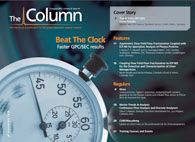Breath analysis
The current method for diagnosis of ventilator associated pneumonia (VAP) can be both invasive and time-consuming. A group of researchers has conducted an initial study into pathogen-derived volatile biomarkers in breath for early and non-invasive diagnosis of VAP.
The current method for diagnosis of ventilator associated pneumonia (VAP) can be both invasive and time-consuming. A group of researchers has conducted an initial study into pathogen-derived volatile biomarkers in breath for early and non-invasive diagnosis of VAP.1
The team conducted in vitro experiments with the bacteria that is most frequently found in VAP patients, Staphylococcus aureus and Pseudomonas aeruginosa, and they investigated the release or consumption of volatile organic compounds (VOCs).
Gas chromatography–mass spectrometry (GC–MS) was used to analyse headspace samples from the bacteria. In total, 32 and 37 volatile metabolites were released by S. aureus and P. aeruginosa, respectively. Distinct differences in the bacteria-specific VOC profiles were found, especially with regard to aldehydes, which were taken up only by P. aeruginosa but released by S. aureus.
The team concluded that the results that they had obtained could detect and perhaps identify the bacteria. This could potentially be used to support the clinical use of breath-gas analysis as a non‑invasive method for early detection of bacterial lung infections.
1. Anton Amann et al., BMC Microbiology12, 113, (2012).
This story originally appeared in The Column. Click here to view that issue.

Determining Enhanced Sensitivity to Odors due to Anxiety-Associated Chemosignals with GC
May 8th 2025Based on their hypothesis that smelling anxiety chemosignals can, like visual anxiety induction, lead to an increase in odor sensitivity, a joint study between the University of Erlangen-Nuremberg (Erlangen, Germany) and the Fraunhofer Institute for Process Engineering and Packaging (Freising, Germany) combined behavioral experiments, odor profile analysis by a trained panel, and instrumental analysis of odorants (gas chromatography-olfactometry) and volatiles (gas chromatography-mass spectrometry).
Investigating 3D-Printable Stationary Phases in Liquid Chromatography
May 7th 20253D printing technology has potential in chromatography, but a major challenge is developing materials with both high porosity and robust mechanical properties. Recently, scientists compared the separation performances of eight different 3D printable stationary phases.
Detecting Hyper-Fast Chromatographic Peaks Using Ion Mobility Spectrometry
May 6th 2025Ion mobility spectrometers can detect trace compounds quickly, though they can face various issues with detecting certain peaks. University of Hannover scientists created a new system for resolving hyper-fast gas chromatography (GC) peaks.

.png&w=3840&q=75)

.png&w=3840&q=75)



.png&w=3840&q=75)



.png&w=3840&q=75)








